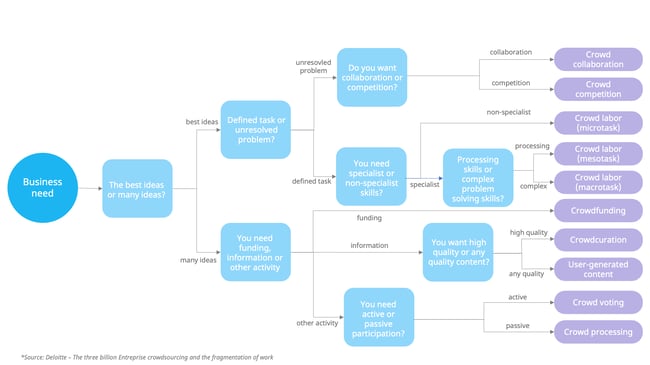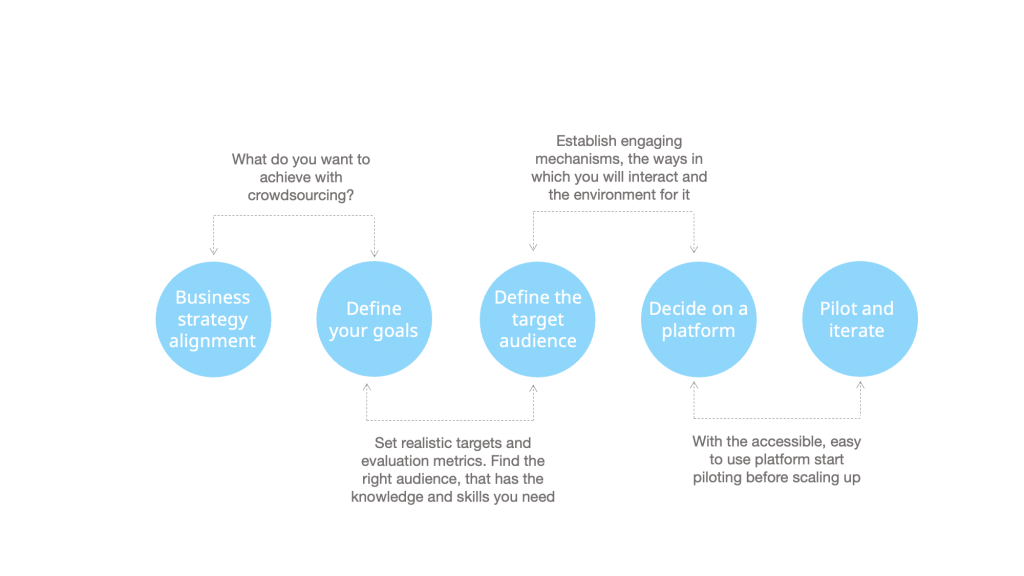How to Overcome Them to Spur Innovation

GUEST POST from Diana Porumboiu
There is a lot of buzz around open collaboration as a driver for innovation. Studies, academia, research, and the myriad of examples from companies are boasting about the amazing results brought by ideas from external parties. A study shows that 85% of the top global brands have used crowdsourcing during the last decade.
But is crowdsourcing truly effective to spur innovation? Even though its popularity increased so much, there’s also plenty of evidence that dispute its effectiveness.
As tempting as it is to fall into the trap of the latest trends in innovation methods, it’s not wise to jump headfirst. So, we decided to write this article and show you the hard facts of crowdsourcing, which will help you decide if this is something your organization can benefit from.
For this, we’ll explain the pitfalls of crowdsourcing and provide practical tips on how to overcome them. To put things in perspective, let’s start with the broader picture, of what crowdsourcing is, or isn’t.
What is crowdsourcing?
As the word indicates, crowdsourcing is all about leveraging the power of the crowds. If you’ve been reading our blog, or worked with innovation topics before, you might think that we are actually referring to open innovation. Not quite. Indeed, the two terms are oftentimes used interchangeably, and the concepts are similar.
But it’s best to make the difference between the two, because setting on the right terminology will also help you better communicate your innovation initiatives to your organization, and to external stakeholders too.
Basically, both crowdsourcing and open innovation refer to engaging external individuals to participate in the innovation process by suggesting ideas and solutions to a specific topic.
Crowdsourcing is the practice of obtaining ideas, solutions, or services from a large, sometimes undefined group of people through an open call. It is a process that leverages the collective intelligence and creativity of a crowd to solve problems, generate new ideas, or carry out tasks.
On the other hand, open innovation includes many other activities that involve people outside the initial working group (open data, scouting, trend research, idea management, etc.). If you want to learn more about the topic, our blog provides vast resources on open innovation which you can find here.
Now, while open innovation, as the name states, is specifically done to generate more innovation, crowdsourcing is used in other contexts too. Methods like crowd labor, crowdfunding, or crowd curation can be valuable if you need to outsource routine and well-defined tasks, manual work or fund your project. These can, in fact, be part of an innovation strategy, but they are not specifically targeting innovation.
That’s where crowdsourcing for innovation comes into play, and what we’ll focus on next.
The pitfalls of crowdsourcing
While crowdsourcing can be an effective way to generate ideas, solve problems, and engage with a community, unless it is properly planned, executed, and managed, it can come up short.
Let’s take a closer look at each of these pitfalls.
There are many risks that come with open collaboration, and some of the most cited are intellectual property and data privacy. Organizations are apprehensive about exposing themselves to the large public and weary about potential conflicts that could arise from ownership, and copyright as well as exposure to competitors.
So, when considering crowdsourcing as part of your innovation strategy, you should weigh the risks associated with it.
There are four main things to keep in mind when it comes to legal risks associated with crowdsourcing:
- Existing patents and patents protection for technical solutions
- Trademarks applicable when sourcing new product names, logos or brands
- Design of the visual appearance of new products
- Copyrights for any original texts
That’s why it’s best to have clearly pre-defined contractual terms, NDAs and confidentiality agreements that deal with intellectual property ownership and data protection. So, make sure to establish clear ownership and copyright guidelines upfront.
This can include requiring contributors to agree to terms and conditions that grant the sponsoring organization the right to use and modify the contributions. Providing clear attribution and recognition for contributors can also help to avoid disputes over ownership. Rewarding participation doesn’t just help with motivation and engagement, but it can also mitigate the legal risks.
The success of your crowdsourcing initiative hinges on the participation of individuals who provide ideas. However, many crowdsourcing projects fall short due to low engagement levels, inadequate idea generation, or low quality.
These issues may arise because contributors don’t recognize the significance of their contributions, lack motivation, misunderstand project requirements, or are unaware of the initiative.
Because crowdsourcing initiatives require a lot of time, effort and specific skills it’s best to delegate the project to someone who is not involved in everyday innovation activities (if you have those already in place).
Even so, crowdsourcing should still be aligned with the overall innovation and strategic goals, and therefore managed as part of existing processes.
To ensure crowdsourcing runs smoothly, contributors are engaged, decide on the roles and responsibilities for managing the process and ensure that there is adequate support for contributors.
Also, to reach the right people, and as many as possible, you should design effective campaigns that encourage participation.
To ensure quality control establish clear guidelines and criteria for contributions. This can include specific requirements for content, format, and presentation, as well as screening and review processes to filter out low-quality or irrelevant contributions.
Using a platform that allows for peer-review or voting can also help to separate the wheat from the chaff. This what can also facilitate evaluation, which we’ll explore next in more detail.
Evaluating ideas is one of the most complex and challenging aspects of idea management, particularly when it comes to crowdsourcing initiatives where you have a significant number of ideas to sift through and assess.
- First, it can be time-consuming and overwhelming to select the ideas to develop.
- Second, ideas and perspectives might differ so there will be inconsistency and biases in the evaluation process.
- Third, there is a tendency to pick the familiar over the distant ones.
- And last, there is also the issue of the quality and level of detail of ideas varying widely, making it difficult to determine which ideas are truly innovative and valuable.
With all these challenges, you could overlook potentially great ideas. What’s more, in a crowdsourcing environment, there is often limited interaction between the idea generators and the evaluators, which can make it challenging to provide feedback and refine the ideas further.
To mitigate this, you need a methodical framework for evaluating ideas. You can learn everything about idea evaluation from this article.
In short, to create an evaluation process that works for you, it’s best to decide on a set of criteria that can help you sift through the ideas. For example, Viima’s evaluation tool gives you the flexibility to choose your own metrics and then analyze and make decisions based on those criteria, without the hassle of going through each of every idea individually.
To have a clearer understanding of how this works in practice, try out the crowdsourcing board template. We set it up so you can easily and safely start collecting ideas from outside the organization.
But remember that even with the best tool, before opening up the organization to the crowds, you will still have to work out your internal process and how that fits into the bigger picture, which takes us to the next point.
Poorly designed or executed processes can lead to low-quality submissions or misunderstandings about the goals of the initiative. A study suggests that besides the issue of managing crowds, organizations also fail to create a process around it.
This is a trap in which many organizations fall. Unless you build a process and plan that goes beyond the first steps of the crowdsourcing initiative, you might waste a lot of time and distract internal teams from using the time and resources on actually executing the strategy.
So, first thing first is to ask yourself if crowdsourcing will serve a bigger purpose. If so, how will it be part of your internal processes and what resources it will require? Crowdsourcing shouldn’t impede internal practices and processes. It should align with the overall strategy and provide value for the organization.
Crowdsourcing shouldn’t impede internal practices and processes. It should align with the overall strategy and provide value for the organization.
Although we have discussed a number of potential pitfalls of crowdsourcing, it’s important to recognize that these issues are often complex and multifaceted. As such, there is rarely a single reason for failure.
To provide a more comprehensive understanding of crowdsourcing, we will next look at some examples of both failed and successful initiatives.
When crowdsourcing goes wrong
1. Pepsi Refresh
In 2010, Pepsi launched “Pepsi Refresh”, a crowdsourcing initiative that invited people to submit their ideas for projects that could benefit their communities, with the winning ideas receiving funding from Pepsi.
While the initiative generated significant attention, it was ultimately considered a failure. Even though in terms of reach and visibility the campaign was a great success, the goal of increasing sale was missed. In fact, “Pepsi Refresh” did the opposite, losing the parent company some $350m.
One reason was the lack of alignment between the initiative and Pepsi’s core brand message. While Pepsi had traditionally focused on promoting its products, the Refresh Project shifted the company’s focus to community engagement and social responsibility.
Another issue with the Refresh Project was the complexity of the submission and voting processes. There were also concerns about transparency and fairness in the voting process. Some critics suggested that the system was easily manipulated, allowing certain ideas to receive more votes than they deserved, while others were unfairly overlooked.
This outcome highlights the importance of ensuring alignment with business strategy and values, as well as the big role played by transparency.
2. Nokia’s “IdeasProject”
Nokia’s “IdeasProject” was a crowdsourcing initiative launched in 2008 to gather ideas from customers and the public for the company’s product development. While the initiative generated significant interest and engagement from users, it ultimately failed to produce significant results, and was eventually discontinued.
One reason for the failure of the IdeasProject was a lack of follow-through and implementation of the ideas generated. While thousands of ideas were submitted and discussed on the platform, few were actually developed or brought to market by Nokia. This led to disillusionment and disengagement among users, who felt that their contributions were not valued or taken seriously.
Another issue was the lack of clear communication and marketing of the IdeasProject. Many customers and potential contributors were not aware of the initiative or did not understand its purpose, which limited the overall reach and impact of the platform.
3. Yahoo’s “Assignments”
In 2007, Yahoo launched “Assignments,” a platform aimed to leverage the collective intelligence of its users to generate high-quality content. The initiative allowed users to submit original content, including articles, photos, and videos, which other users could rate and review. Yahoo planned to use the best-rated content to enhance its news and information websites.
Yahoo failed to create a strong community around the initiative, which made it difficult to generate high-quality content. Furthermore, there were concerns about copyright violations, as some of the content submitted by users was copyrighted material.
Because the platform was plagued with issues, including a lack of quality control over articles submitted and disputes over payments to writers, the platform was eventually shut down in 2012.
When crowdsourcing goes right
Despite the challenges associated with crowdsourcing, we should acknowledge that there is still potential for success, and not all crowdsourcing efforts are doomed to fail.
1. Linux
Linux is a popular open-source operating system that was developed through a crowdsourcing initiative. The project was started by Linus Torvalds in 1991, who was a computer science student at the University of Helsinki in Finland. Torvalds wanted to create a free and open operating system that could be used by anyone, and he enlisted the help of other developers from around the world to contribute to the project.
The project’s success is attributed to its collaborative and decentralized development model, which fosters innovation and customization, as well as a strong community of passionate and supportive developers. Moreover, Linux’s technical merits, such as stability, security, and flexibility, make it a popular choice for a diverse range of applications, from web servers and supercomputers to smartphones and home appliances.
2. Ford
The “Make it Driveable” crowdsourcing campaign by Ford was launched in 2018 to gather ideas and solutions for making vehicles more accessible to people with disabilities. The campaign invited individuals and organizations to submit their ideas for features or modifications that would make driving and traveling in a car easier for people with disabilities.
The campaign engaged a diverse range of people and organizations, including disability advocates, engineers, and designers, in the co-creation process who generated a broad range of innovative ideas and solutions.
The “Make it Driveable” campaign showcased Ford’s innovation and leadership in the automotive industry, demonstrating the potential for crowdsourcing to drive meaningful change and create value for both the company and its stakeholders.
3. Lego
As mentioned above, Lego’s crowdsourcing platform, Lego Ideas has been running successfully since 2008. The platform allows Lego fans to submit their own designs for new Lego sets, and the community votes on their favorite designs. The Lego Ideas platform has been hugely successful, with several of the winning designs becoming popular and highly sought-after sets.
For Lego, crowdsourcing is a cost-effective approach to supplement its in-house capabilities and expand their line of products. Even more, because of the voting system they can assess whether a product idea has potential and demand among its customers.
For participants, Lego Ideas provides a valuable platform to share and contribute to the company’s mission of inspiring future builders. Users can gain recognition from their peers for their ideas and benefit financially if their product is successfully released to the market.
These are just a few examples which show how crowdsourcing can be applied successfully, as long as it’s in line with the company’s core values and goals, and it’s built on a framework that enables systematic use of the ideas from outside the organization.
But as previous examples have shown, crowdsourcing can also go wrong even for the most successful organizations. These examples can hopefully help you make a more informed decision, and inspire in the way you approach crowdsourcing, or open collaboration in general.
To recap, you need alignment between your crowdsourcing initiatives and the overarching strategy, integration with internal processes, a framework that enables idea management, evaluation and development and last but not least, an effective campaign to gather the crowds around your organization.
How to start crowdsourcing
First thing first. Does crowdsourcing align with your current strategic plans? If it does, the first step is to develop a clear plan for using crowdsourcing effectively.
If you are not sure which way to go, as a first step in choosing your approach, you can find inspiration in this chart from Deloitte, which shows a variety of crowdsourcing activities that cater for different needs.

Depending on your strategy, industry, and your company profile, you will probably know what type of crowdsourcing is most appropriate for your organization.
This will help you decide on other factors such as the type of contributions you are after, the resources required, and the audience you will target.

1. Define your goals and set boundaries
The first step is to set clear goals for your crowdsourcing campaign. What do you want to achieve: is it brand awareness, ideas for improving products or customer satisfaction?
Decide on a set of metrics that will help you evaluate the success of the campaign and measure its impact. This will help you adjust as needed but also set realistic targets about the outcomes you think are possible. If you’re set to get disruptive or completely novel ideas that require technical knowledge and complex solutions, you have to carefully consider whom you want to target with the campaign.
2. Define the target audience and the engagement mechanisms
This step is essential for the success of your crowdsourcing. Without the right participants, you won’t have enough relevant ideas.
Think about who would have the most knowledge and expertise in this area and who would be most interested in providing their ideas and insights. Consider demographics such as age, occupation, location, and interests.
Depending on the goals you set or the types of ideas you are after, you will need different audiences. Sometimes there might be more generic ones, while in other cases you will want specific people with knowledge of the topic or interest in the field. On the other hand, sometimes it is more beneficial to have a diverse audience that can bring new and fresh ideas.
Once you have identified your target audience, you need to develop engagement mechanisms that will motivate them to participate in your crowdsourcing campaign.
Engagement mechanisms refer to the various ways in which you can interact with your target audience and encourage them to contribute their ideas. These mechanisms may include online platforms, social media channels, email campaigns, targeted advertising, events, and rewards or incentives.
It’s important to remember that engagement mechanisms should be designed specifically for the target audience.
3. Decide on a platform to support your activities
Once you have decided on the goals, determined the target audience, and the engaging mechanisms, you should next look for a platform that can cater to all your needs.
The platform should act as a transparent communication and exchange forum for participants. It should be easily accessible and simple to use, but also flexible enough to allow different use cases.
As mentioned above, many crowdsourcing failures are related to the inability of organizations to manage and integrate the initiative in their existing processes. Providing feedback and encouraging ongoing participation are also other important elements to consider when scouting for a crowdsourcing tool.
To get an idea of what open innovation platforms are out there and how they can be used for crowdsourcing, you can read this Guide to Open Innovation Platforms: How to Unlock the Power of Collaboration.
The selection criteria should consider factors such as accessibility to the target audience, the ability to integrate relevant engagement mechanisms to promote ongoing participation, and the capability to distribute incentives after the completion of activities.
4. Pilot and iterate
Consider starting with a pilot initiative to test the approach before scaling up.
No matter how well you prepare for something new, like crowdsourcing might be for some, you will most likely stumble a couple of times. And that’s completely fine.
No amount of research and shortlisting will give you the full scope of how it works in practice for your organization. That’s why it’s important to pilot on a smaller scale. And once you’re happy with the pilot results you are ready to scale up.
Doing pilots allows you to test the platform, check for compatibility with the platform, and test your plan and ways of working.
If you are not sure about the first step, get started with a platform and see how it would work in practice internally. Some vendors offer free user-based versions, like us here at Viima, and some have demos or other free trials.
Additionally, piloting may also help evaluate if you’re searching via the wrong criteria (of if your goals are misguided), or if your ways of working or processes are wrong for what you want to achieve. Also, consider using feedback from participants to iterate and refine the initiative over time.
Conclusions
As you can see, just as there are good parts about crowdsourcing, there are also bad ones. There is no one size fits all solution when you want to innovate, and just like many other methods and tools, crowdsourcing can be a great enabler for innovation.
Regardless of the pitfalls and numerous failures from other companies, crowdsourcing can still be highly beneficial for your organization.
To summarize, let’s recap the positive aspects of using crowdsourcing for innovation and the main factors to consider to fully leverage its benefits.
First, for crowdsourcing to work well, it should make sense for the organization’s strategy and overall goals. Make a plan, assess the needs and the capabilities to manage a process like this. Because indeed, crowdsourcing should be designed as a process that complements, and doesn’t hinder other activities within the organization.
Second, make sure you choose the right platform from the get-go. For optimal results you should aim for something that is flexible enough that allows multiple uses, from external idea collection to managing the entire innovation process.
Lastly, don’t over-rely on technology either, because that is just a tool that helps you move forward and be more efficient. The true benefits come when you start building connections, nurture talent and find new approaches to solve problems.
Image credits: Viima, Pixabay
 Sign up here to join 17,000+ leaders getting Human-Centered Change & Innovation Weekly delivered to their inbox every week.
Sign up here to join 17,000+ leaders getting Human-Centered Change & Innovation Weekly delivered to their inbox every week.
 Drum roll please…
Drum roll please…![]() Sign up here to get Human-Centered Change & Innovation Weekly delivered to your inbox every week.
Sign up here to get Human-Centered Change & Innovation Weekly delivered to your inbox every week.



 Innovation is not a solo activity. While the rare lone genius may be able to invent something on their own (although still always inspired by others), nobody can innovate by themselves. Innovation, by its very nature, requires collaboration.
Innovation is not a solo activity. While the rare lone genius may be able to invent something on their own (although still always inspired by others), nobody can innovate by themselves. Innovation, by its very nature, requires collaboration. What does an innovation coach look like?
What does an innovation coach look like?
